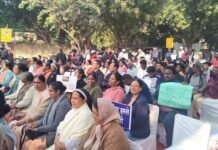Ramallah – In the Arab city of Jenin, 26 km north of Nablus, out of 70 thousand inhabitants there are only 130 Christians, almost all Catholics of the Latin rite. In Tubas, another Arab town in the northern West Bank, the inhabitants are 40 thousand, and there are only 45 Christians, belonging to the Greek Orthodox Church; In Burqin, a Palestinian village not far from Jenin, Christians are less than 70, out of a population of 7500 inhabitants; even the baptized communities present in the towns of Jalameh and Kafr Koud are composed of a few dozen people. While in the village of Deir Ghazaleh, inhabited by a substantial Christian minority until 10 years ago, now the baptized are only 4 out of 1200 inhabitants.
The phenomenon of the decrease of the Christian population in large territories of the West Bank submitted to the Palestinian Authority emerges in objectively impressive terms in the numbers shown in a brief contribution signed by Hanna Issa, member of the Council of Fatah and General Secretary of the Palestinian Islamic-Christian Council for Jerusalem and the Holy Places. In the text, also relaunched by the website abouna.org, Hanna Issa calls into question the “political and economic factors” at the origin of the migratory flows that are drastically reducing the Christian presence in the West Bank.
The Palestinian national project is based on the recognition of full equality among citizens of different religions, but political instability translates into social and economic instability. This is why – concludes Hanna Issa – it is necessary to preserve the Palestinian Arab identity in the face of all the conditionings that can generate situations of discrimination in Palestinian society and marginalization of its Christian component.




As I understand it from Christian sources in Israel there has been a concerted effort by West Bank authorities to remove Christians from Bethlehem through harassment, persecution, rape and forced marriages. Some Arab Christians are finding refuge in the State of Israel, whilst Israeli / Jewish Christian congregations are also growing despite active persecution by the religious Jewish groups..
Agreed. I was in Israel at the end of last year, and spoke to some of the Anglican Christian community. They said exactly the same as the comments you have made dannybhoy.
Yes. I have spent considerable time in Israel over the years, and have spoken at length with both Palestinian and Israeli Christians of many denominations.